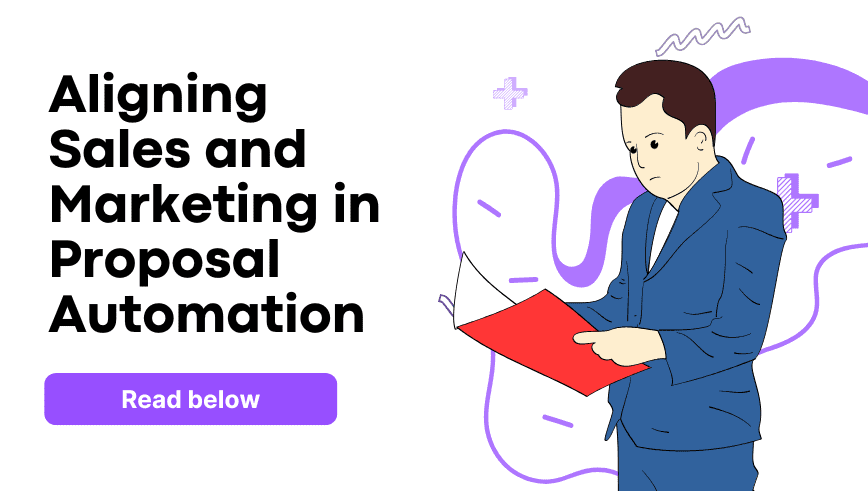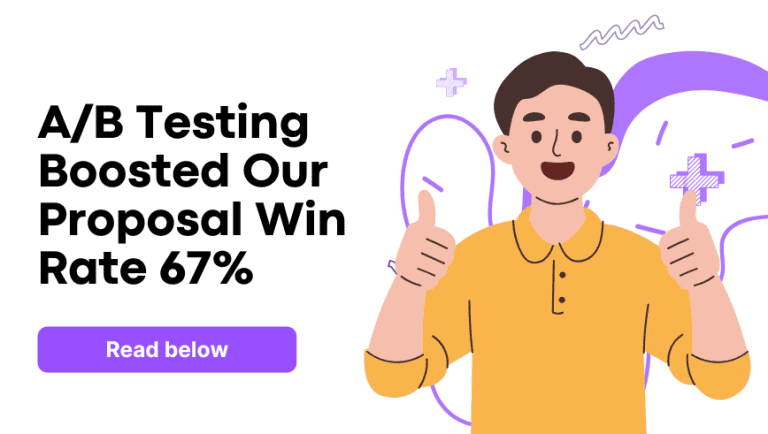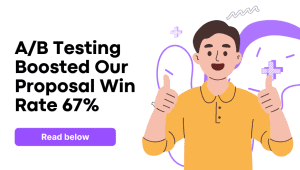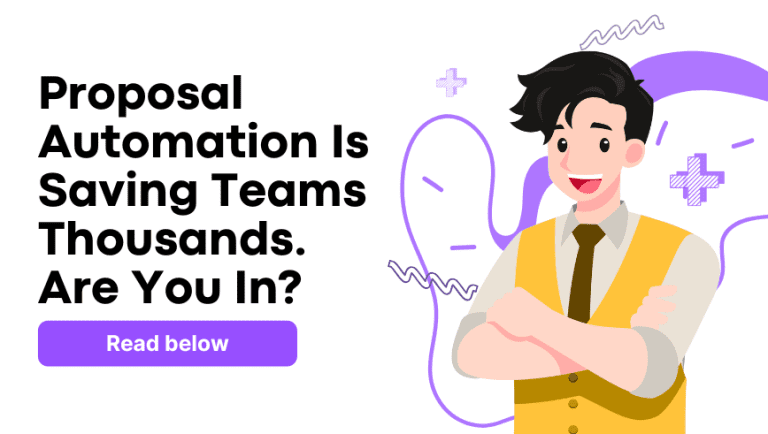Let’s start with something most teams don’t say out loud.
Sales and marketing teams often believe they are aligned. They’re in the same Slack workspace. They attend the same Friday check-ins. They might even use the same Google Drive folder. But when someone in sales is asked about the latest marketing campaign, they’re unsure. And when marketing is asked what kind of leads sales is hoping for, the answers are usually broad. The transition between a Marketing Qualified Lead (MQL) and a Sales Qualified Lead (SQL) is not always smooth.
Now, enter proposal automation. Done right, it creates clarity and connection. That’s what we’re focused on at Proposal.biz: helping companies get real Sales and Marketing Alignment through structured workflows and shared proposal tools. Our goal is to deliver not just more proposals, but better ones, with messaging that speaks directly to what the lead wants to see.
What is Sales and Marketing Alignment?
Sales and marketing alignment refers to the process of both teams working toward shared revenue goals, using unified messaging, targeting the same buyer personas, and passing leads through an agreed system of qualification.
This alignment is most effective when supported by shared tools, such as sales proposal software and marketing automation software. Together, they keep messaging consistent, reduce delays in lead handoff, and track performance across the full customer journey.
Why Sales and Marketing Alignment Often Fails
Everyone is working hard. Sales wants more conversions. Marketing wants better campaign performance. But their tools, metrics, and reports do not always overlap. Marketing might be buried in a marketing automation software dashboard, analyzing click rates. Sales is busy with follow-up notes inside the CRM. The handover point between teams is blurry.
This creates a few common issues:
- Leads are sent forward without full context.
- Sales teams rewrite proposal content without knowing what worked previously.
- Marketing runs campaigns without feedback from closed deals.
What ends up getting impacted is clarity, consistency, and the overall voice of the brand.
A Common Framework & A Shared Language
Proposal automation isn’t just fast. It’s structured. With the right sales proposal software(INTERLINK – How to choose enterprise RFP software), both teams rely on the same proposal content management system. It becomes a shared content library that is pre-approved, well-organized, and effective.
Instead of reworking each proposal from scratch, sales can pull from trusted modules. Marketing doesn’t need to chase sales for usage data. Everyone is looking at the same building blocks.
This leads to:
- Clear, persona-based modules created by marketing.
- Efficient assembly and personalization by sales.
- Shared performance data on which proposals close deals.
Everyone works with the same tools. Everyone speaks the same language. Both teams benefit when buyer personas become a focal point. Marketing builds persona-rich content modules. Sales uses these modules in proposals, ensuring relevance and clarity. Proposal automation keeps persona-aligned sections visible and trackable, so both teams know what resonates most.
From MQL to SQL: The Proposal Becomes the Pivot
Proposals often show the first true sign of whether sales and marketing alignment is working. At this stage, a prospect is making real choices. The proposal becomes a key moment in the buying journey. And let’s not forget that there are different types of proposals that cater to different requirements.
Proposal automation brings data and context together. Marketing can study which campaigns led to proposal opens, time to close, and average deal value. Sales can see the entire journey of a lead before they even speak.
This feedback loop keeps both teams connected.
How Proposal Tools Enhance Lead Quality
Most teams spend hours defining what makes a good lead. But the real measure comes when that lead receives a proposal. That’s where intent meets value. Proposal automation helps close the gap between marketing’s messaging and sales’ follow-up.
With tools built for both teams, it becomes easier to:
- Score leads based on content interaction.
- Personalize proposals based on previous campaign data.
- Connect marketing automation software data with proposal outcomes.
When used alongside sales marketing automation platforms, proposal tools help refine what qualifies a lead. Instead of relying on assumptions, teams use data from both systems to improve targeting and timing. The result is fewer dead-ends and more qualified conversations.
By using shared sales proposal software that links back to campaign sources, you can finally trace which marketing efforts bring in high-value clients.
The Role of AI in Proposal Automation and Alignment
AI is quietly becoming a powerful part of how sales and marketing teams work together. In proposal automation, it enhances everything from content recommendations to lead insights. Instead of guessing what to include in a proposal, AI analyzes past wins, buyer behavior, and engagement data to suggest what works best for each lead.
AI also helps both teams stay on the same page. For marketing, it offers data-backed feedback on which campaigns produce high-converting leads. For sales, it generates proposal outlines based on CRM entries, product details, and even tone preferences.
At Proposal.biz, we’re building our platform with AI as a core layer. From auto-suggested proposal sections to adaptive templates and real-time engagement tracking, we’re exploring how AI can reduce proposal prep time while increasing accuracy.
We also offer AI integration services for companies that want to add intelligent workflows into their own stack, from CRM sync to content analysis, tailored to your sales and marketing flow.
Proposal automation with AI doesn’t replace your team. It makes your team faster, sharper, and more consistent.
Speed + Strategy = Growth
Marketing automation software helps bring in leads. Proposal automation helps finalize those leads.
Together, they allow for:
- Smarter decisions based on proposal acceptance patterns.
- Faster handoffs using shared tools.
- Streamlined messaging backed by actual results.
Internal benchmarks show that strong Sales and Marketing Alignment through proposal automation improves customer retention and deal velocity. These are outcomes that come from using shared workflows with purpose.
Top Benefits of Sales and Marketing Alignment Through Proposal Automation
Here are some of the key benefits businesses experience when they align their sales and marketing functions with proposal automation:
– Faster proposal turnaround time
– Better quality leads, based on shared qualification models
– Stronger brand consistency across outreach and sales decks
– Clear performance tracking through shared proposal content management
– Higher win rates and improved buyer experience
– Shorter sales cycles from first touchpoint to closed deal
Each of these outcomes contributes to a more predictable and scalable growth process.There are further supplemented by benefits that a proposal software provides to both the teams.
What Most Teams Overlook
Alignment doesn’t happen in a quarterly report. It’s built day to day, through consistent collaboration. That includes small but important moments, like the tone of a proposal introduction or the order of proof points.
When sales works from scattered notes or old PDFs, they lose time. When marketing doesn’t know what’s being sent out, they can’t measure or improve.
Proposal content management creates an environment where both sides contribute to a shared product. It’s a working system that grows with each use.
Collaboration Cadence and Shared Planning
Real alignment happens in the context of regular collaboration. Many high‑performing teams follow routines like:
– Weekly alignment sessions between SDRs and marketing to review MQL quality and campaign performance
– Persona-focused workshops so both teams understand buyer motivations
– Shared content calendars where marketing lists upcoming campaigns and sales adds feedback or support assets
– Training sessions where sales demonstrates common buyer questions and marketing adjusts content accordingly
These routines reduce friction, improve content accuracy, and give purpose to the shared repository in your sales proposal software.
Proposal Automation Brings Confidence
Efficiency is one outcome. Clarity is another.
When sales knows that the proposal content is tested and on-brand, they stop recreating the wheel. When marketing sees what’s getting used and why, they adjust campaigns with real insight.
Everyone sees what’s working. Everyone builds on that knowledge.
Content Governance and Brand Consistency
One of the most underrated benefits of proposal automation is maintaining brand consistency across touchpoints. When every proposal uses the same content blocks, visuals, and voice that marketing defines, it builds trust and credibility with prospects.
Proposal content management allows businesses to set up content governance rules that define tone, visuals, and approvals. Sales teams then pull content that has already been reviewed, saving time and ensuring proposals always reflect the brand’s core messaging.
Metrics That Matter: Measuring True Alignment
It’s one thing to say your teams are aligned. It’s another to see it in numbers. When you’re using a proposal automation system with built-in analytics and shared content governance, the right data becomes easier to track.
Some key metrics that reflect strong sales and marketing alignment:
- Average time from MQL to proposal sent
- Proposal open and response rates by lead source
- Content performance within your proposal content management system
- Feedback loops from closed-won and closed-lost opportunities
- Studies show aligned teams enjoy 27 percent faster revenue growth and 36 percent higher retention
When both marketing and sales rely on the same data inside a unified tool, each proposal goes beyond being a document and becomes a lesson. Over time, teams can refine what works best, build shared dashboards, and adjust proposal strategies based on actual buyer behavior.
It’s alignment that grows stronger with every deal.
Setting Shared Commitments: The Role of SLAs
Alignment improves when teams set clear agreements. A sales & marketing SLA states what marketing delivers (e.g., number of MQLs) and what sales does in return (e.g., follow-up timing).
With proposal automation in place, these commitments become easier to monitor. Marketing sees how quickly proposals go out after MQL handoff. Sales notes how many leads from each campaign become SQLs or proposals.
This type of SLA strengthens:
– shared goals
– shared accountability
– performance insight within a unified system
The result is stronger sales and marketing alignment and better business outcomes.
What We’re Building at Proposal.biz
We’re building a tool that brings teams closer, not just faster. Proposal.biz is designed as both a sales tool and a marketing tool. It supports drag-and-drop templates, real-time collaboration, and organized proposal content management.
Each feature is aimed at reducing repeated work and improving message quality. Instead of passing documents back and forth, teams work together from the start.
The system helps:
- Standardize messaging.
- Highlight winning templates.
- Capture performance insights.
This way, each team contributes to every win.
Turning Alignment into an Advantage
With a proposal system built for collaboration, your proposals improve with each iteration. Sales and marketing teams operate with shared goals and shared data. Messaging stays clear. Timelines get shorter. Prospects experience a smoother journey.
By pairing sales marketing automation with a tool like Proposal.biz, businesses move from fixing problems to scaling success.
We’re close to launch. And when we do, our aim is to provide a solution that feels natural in your process. One that supports your sales and marketing alignment efforts from the first campaign to the final proposal.
Let’s build something better together.




